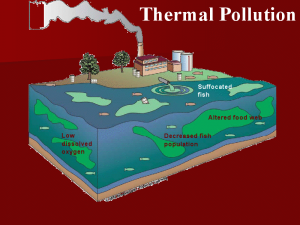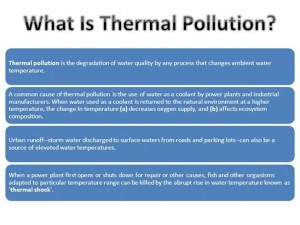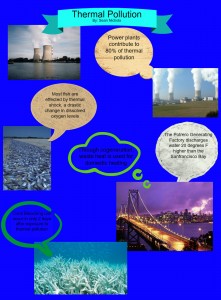Thermal Pollution is an offshoot of rapid urbanization and unplanned industrialization with a heavy demand on thermal power palnts. Thermal Pollution may be defined as the warming up of the aquatic system to a point where the activities of aquatic plants and animals are adversely effected because of the discharge of heated effluents from the thermal power plants. Normally the aquatic life is well adjusted to dirurnal of heated effluents from the thermal power plants. Normally the aquatic life is well adjusted to diurnal and seasonal changes in temperature which occur naturally. However, due to man-made activities, rise in temperature of the water body brings about adverse changes in the ecological sufficient to damage the productivity and sustaining of aquatic life. Thus, when the heated effluents are discharged at a temperature 8 degree – 10 degree Celsius higher than the temperature of receiving water, significant changes are brought about in the aquatic system which disturb and damage the aquatic system.
SOURCES OF THERMAL POLLUTION
- THERMAL OR NUCLEAR POWER GENERATING PLANTS are the most important source of thermal pollution as these contribute as much as 75 percent heat discharged by the heated effluents to the body of stream water. Besides effluents, emission from nuclear reactors, processing instruments and institutes carrying in out nuclear experiments are also responsible for increasing temperature of the stream water. In a coal-fired power plant, 70 percent of the total heat produced is discharged as waste heat. Nuclear power plants discharge alittle more heat than the coal-fired plants, producing are equivalent amount of electricity. A large fraction of this heat goes to the cooling waters, drawn from the stream and returned to the system and returned to the system as heated water. It is estimated that heated water from thermal or nuclear power plants could raise the temperature to about 10 degree- 14 degree Celsius higher than the temperature of the receiving water.
- INDUSTRIES generating electric power require large amounts of cooling water for removal of heat, Industries like textiles, paper, pulp, sugar release lesser heat into the receiving water. However, heat from turbo-generators installed in the industries, have effluent temperature 5 degree-9 degree Celsius higher than the normal temperature of the receiving water. Because of the large number of units employed by the industries, the accumulated heat discharged into the stream naturally raises its temperature much higher than the normal temperature.
- Domestic and Municipal Sewage discharging into a running stream with or without treatment also contribute to thermal pollution as their temperature is generally 4 degree- 8 degree Celsius higher than that of the receiving stream water. The discharged sewage when untreated because of its pathogenic contents creates numerous deleterious effects on the aquatic biota. Besides, the organic matter depleting the stream’s dissolved oxygen supply necessary to sustain aquatic life. Consequently the aquatic life is adversely affected.
EFFECTS OF THERMAL POLLUTION
- Decrease in dissolved oxygen – The concentration of dissolved oxygen (D.O) in water decreases with rise in temperature. While the D.O. content is 12.8 mg/l at a temperature of 5 degree Celsius, it is 6.6 mg/L at 40 degree Celsius. In an aquatic system saturated with oxygents at lower temperature, rise in water temperature causes oxygen to form bubbles to escape from the system. Gas bubbles are also formed within the bodies of the aquatic animals i.e. fish which are injurious, as they cling to the gills and block oxygen in take this forces the fish to breathe in air which they cannot, thus choking them to die.
- BOD attained at lower temperature – when the temperature of stream carrying biodegradable organic matter rises, the intensified action of organisms causes BOD to be attained at a lower temperature. With rise of temperature, the chemical and biochemical action of the organic matter are accelerated depleting oxygen supply, thereby causing fish to perish .
- Interference with biological activities – Due to rapid change in temperature, the physiology, metabolism and biochemical process in controlling respiration, excretion and overall development of aquatic organism undergo changes, which descript the entire ecosystem leading to its slow death.
- Increased vulnerability to diseases – At higher temperature, pathogenic microorganisms become more active ushering in infections to aquatic plants and animals, making them fall prey to disease and debility.
- Increase in metabolic activity – The metabolic reactions in a biological system is increased with rise in temperature, which causes an increase in demand of oxygen. Fish normally survive at temperature below 35 degree Celsius, but temperature above 35 degree Celsius because increased activity which exhausts many aquatic organisms and cuts shorts their life span. This may also result in premature deposition of eggs in same aquatic animals thus triggering of reproduction process.
Heated waters, because of less density rise to the top and float over the water surface causing stratification. The insulates the lower layers of water from the atmosphere above with the result, the exchange of gases from water surface stops. Species intolerant to higher temperatures migrate to lower layers which are relatively cooler and denser. All this cumulatively results in creating oxygen deficit in both upper and lower layers.





Leave a Reply